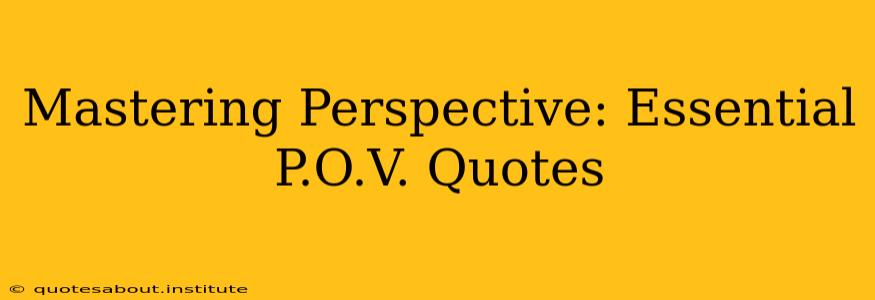Point of view (POV) is the crucial lens through which your reader experiences your story. Choosing the right POV – first person, second person, third person limited, or third person omniscient – dramatically shapes the narrative and reader engagement. While mastering POV is a skill honed through practice, understanding the nuances of each perspective is paramount. This guide explores the core elements of POV, offering essential quotes to illustrate its power and impact, and answering common questions writers face.
What is Point of View (POV) in Writing?
Point of view in writing refers to the narrative perspective from which a story is told. It dictates who is telling the story and what information the reader has access to. The choice of POV significantly impacts the reader's emotional connection with characters and events. A well-chosen POV can enhance immersion, create suspense, and deepen the reader's understanding of the narrative's themes.
Key takeaway: Your POV choice directly impacts reader engagement and the overall impact of your storytelling.
Essential Quotes Illustrating Different POVs
Let's look at some fictional examples illustrating how different POVs affect the narrative:
-
First Person: "I knew then, standing on the precipice, that my life was irrevocably altered. The wind whipped around me, mirroring the turmoil in my soul." (This directly immerses the reader into the character's thoughts and feelings.)
-
Second Person: "You step into the dimly lit room, the air heavy with the scent of old books and dust. You can feel the weight of history pressing down on you." (This directly addresses the reader, making them an active participant in the story.)
-
Third Person Limited: "He watched her from across the crowded room, his heart pounding a frantic rhythm against his ribs. He couldn't understand why she wouldn't look at him." (The reader only sees the story through this character's eyes and emotions.)
-
Third Person Omniscient: "She felt a surge of anger, while he, unbeknownst to her, was wrestling with a profound sense of guilt. Their destinies, intertwined despite their awareness, were about to collide." (The narrator has access to the thoughts and feelings of multiple characters.)
Common Questions About POV: People Also Ask
Here are some frequently asked questions about point of view, addressed to provide clarity and guide aspiring writers.
What is the difference between first-person and third-person POV?
The primary difference lies in the narrator. First-person POV uses "I" and is told from the perspective of a character within the story. Third-person POV uses "he," "she," or "they" and can be limited (access to one character's thoughts and feelings) or omniscient (access to multiple characters' thoughts and feelings). The impact differs greatly: first-person offers intimacy, while third-person allows for broader scope and perspective.
When should I use second-person POV?
Second-person POV, using "you," is less common but can be incredibly effective when aiming for a highly immersive and interactive experience. It often works well in interactive fiction, choose-your-own-adventure stories, or when addressing the reader directly as a character. However, overuse can feel intrusive and disorienting.
How do I choose the right POV for my story?
The best POV depends entirely on your story and what you want to achieve. Consider:
- Level of intimacy: First-person offers the most intimate view.
- Scope of the narrative: Omniscient allows for a broader perspective.
- Character development: Limited POV can focus on a single character's arc.
- Reader experience: Second person creates unique immersion.
Experimentation is key. Try writing a scene in different POVs to see which best serves your vision.
Can I change POV within a story?
While generally discouraged, shifting POVs can be done effectively but requires careful planning and execution. Sudden shifts can be jarring, so any change must be strategically executed, often to emphasize a specific plot point or reveal crucial information. Consistency is vital for a smooth reading experience.
Conclusion: Mastering POV for Enhanced Storytelling
Choosing and consistently applying the correct POV is fundamental to effective storytelling. Understanding the strengths and limitations of each perspective is crucial for crafting compelling narratives that resonate deeply with your readers. By mastering POV, you enhance the reader's journey, deepen character development, and elevate your writing to new heights. Continuously experimenting and refining your technique is the key to becoming a truly skilled storyteller.

